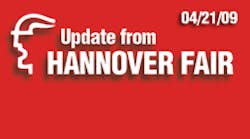April 21, 2009 - Wind-turbine drive takes the prize at Hannover Fair
Despite the tough economic times, this year’s edition of the Hannover Fair opened Monday with 6,150 exhibitors from 61 countries — numbers on par with the last couple of years. And while first-day attendance wasn’t overwhelming, companies showing new products offering improvements in energy efficiency, a competitive edge for users, or simple cost savings still managed to attract a crowd.
Probably the biggest news Monday was the € 100,000 Hermes prize awarded to the Voith Turbo Wind company, based in Crailsheim, Germany, for a new concept in wind-turbine rotors.
To feed the power grid through synchronous generators, variable wind speed needs to be converted to a constant output speed. The WinDrive system is the first dynamic variable-transmission applied to the drivetrain of a wind turbine without a frequency converter.
The drive system is based on a hydrodynamic converter in combination with a superimposing planetary gear stage. The system converts the variable speed of the wind-turbine rotor into a constant output speed for the generator. Control response takes as little as 20 msec, letting synchronous generators directly feed the power grid.
Eliminating a frequency converter results in a considerable reduction in weight. The system is said to be highly reliable with an extremely low failure probability and excellent feed qualities to the electrical grid, based on its high-frequency stability and ability to equalize load peaks.
Keeping with the sustainability theme, Parker Hannifin (parker.com) introduced a range of simple ac drives for permanent-magnet motors up to 7 kW. Used with permanent-magnet ac motors without speed sensors, the AC650S Series reportedly offers energy savings and a more-compact size compared with conventional systems based on induction motors. Target applications include fans, pumps, compressors, conveyors, and machine tools. --- Parker also displayed what they believe is the world’s first servodrive to combine three servo power stages in a single unit. Called TPD-M, the new drive is for applications that normally use multiple drives. The drives are especially suited for centralized automation systems, such as in packaging machines, which normally require many drives. By replacing three drives with one, the unit saves weight and space in control cabinets and cuts component costs, as only one set of cables, connectors, filters, and braking resistors are required.
With acceleration rates of 140 m/sec2, new linear-motor direct drives from Festo (festo.com) are for fast-acceleration, high-precision applications such as in photovoltaics production, medical imaging, electronics manufacturing, and assembly of small parts. The company reports acceleration is 1.5 to 4 times that of other typical electric and pneumatic drives, and two to three times faster than electric axes with a spindle or belt drive.
DNCE-LAS and DFME units have the same interfaces as the company’s pneumatic actuators, letting them fit seamlessly into modular mechatronic multiaxis systems. They can combine with other electric and pneumatic drives for gripping, joining, and positioning, as well as complete handling systems.
ELGL-LAS linear-motor axes include an air bearing. This permits highly dynamic horizontal and vertical positioning. The air bearing contains permanent magnets that create a strong attraction between the carriage and base. Compressed air fed between the magnets and base creates an air cushion as a counterforce to the magnetic attraction. The carriage lifts and moves without dynamic friction.
The air bearing with its magnetic bias makes the axis precise and torsionally rigid and, at the same time, is unaffected by dirt particles. Thus, it resists wear and is virtually maintenance-free. When the air bearing switches off, the magnets act as a holding brake.
To counter a growing problem with counterfeiting and substandard knockoff seals, particularly in critical applications such as aerospace, Simrit (simrit.com) announced a new antifraud marking process for seals, diaphragms, and elastomeric components.
The laser-marking process, called Secure Adaptive Freudenberg Encryption, provides clear production identification with information covering part description, model, dimensions, material, date of manufacture, and serial number for reliable traceability and to guard against counterfeiting. Products can be marked with a tiny, rectangular code for flat surfaces, or as distorted product markings for O-rings. The code remains legible through a vision system and proprietary software even if up to 70% of the marking has been destroyed, say through wear. Conventional machine-read codes, such as data-matrix codes, cannot provide the high capacity needed to identify seal components, say Simrit officials.
